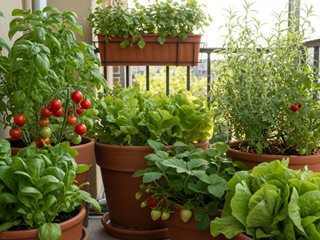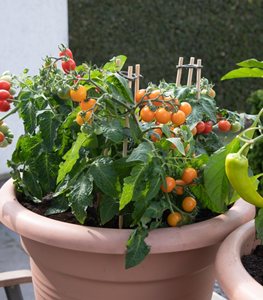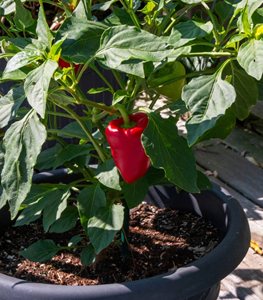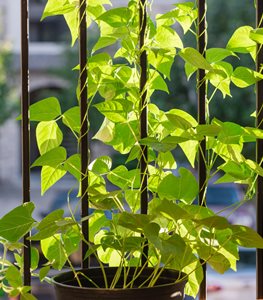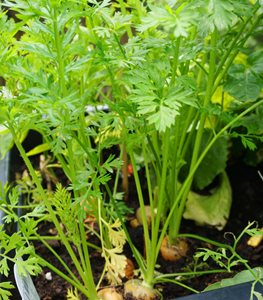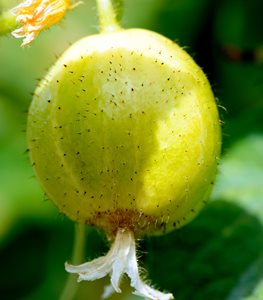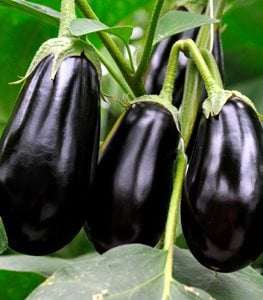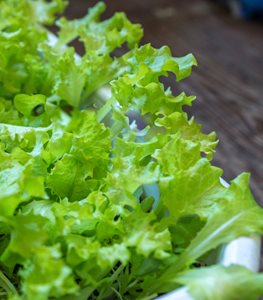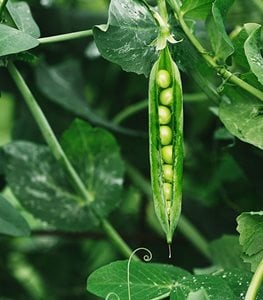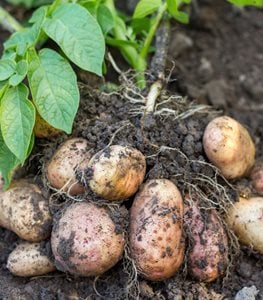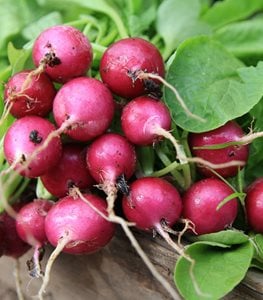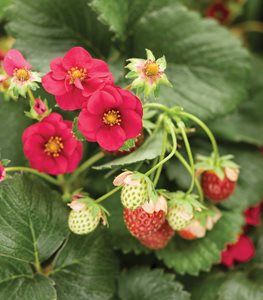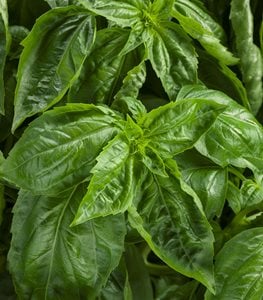Container Gardening: Growing Vegetables in Pots
Grow your own fresh food, even in a limited spaceIf growing your own vegetables and herbs sounds appealing but you don’t have a lot of space, containers are a viable alternative to the traditional kitchen plot. All you need is a balcony, patio, deck, or other small space that gets at least 6 hours of direct sun. The reasons to grow your own food in containers are many:
- Home-grown produce tastes better than store-bought and is often more nutritious.
- Containerized vegetables are more accessible, usually grown right on your doorstep.
- Some vegetables do better in containers, while some won’t perform well at all.
By choosing the right vegetable varieties and following some basic tips, you can be well on your way to growing and harvesting your own farm-fresh food at home.
Learn more about growing vegetables in small spaces.
STARTING YOUR CONTAINER VEGETABLE GARDEN
Evaluate your site:
- Make sure your site receives adequate light by observing how the sun moves throughout the day.
- In hotter climates, plants may need afternoon shade so they don’t overheat.
- Measure the space to make sure there’s enough room for the containers that you’ll need.
- To maximizet to g the use of your space, include plants that grow vertically such as peas, pole beans and cucumbers.
- Make sure there’s a convenient source of water close by.
Make a plan:
Draw up a quick sketch to calculate how many containers you’ll need, and in what sizes. Make a list of supplies, including containers, soil, garden tools, seeds, plants, watering supplies, fertilizer, and plant supports such as trellises and cages.
Choose what to grow:
Make a wish list of what you’d like to grow, focusing on what you are most likely to eat. Limit to what you have time and space for and include easier varieties such as lettuce and radish to maximize your success.
(Tip: When looking at catalogs, online sources, and plant labels, look for descriptive words such as dwarf, compact, patio, bush, and space saver, which indicates smaller varieties more suited to containers.)
Seed vs. starts:
Quick growers such as lettuce, bush beans, and peas are easy to grow from seed. Plants that take longer to mature such as tomatoes, peppers, and eggplant are best grown from nursery starts.
Choose containers:
Almost anything can act as a container providing it’s big enough, has good drainage, and is made from food-safe material. Here are some tips for choosing containers:
- Leafy greens, radishes, and other shallow-rooted vegetables need less space than plants with deeper roots such as tomatoes and peppers.
- Large pots are better, as they won’t dry out as quickly and have plenty of room for root development.
- Choose containers that are at least 12 inches tall and deep, such as 5-gallon size or larger plastic pots, wooden planter boxes, or half whiskey barrels.
- Avoid terra cotta or clay pots, which dry out quickly, as they allow water to evaporate through the walls of the pot.
- Also avoid metal and dark colored containers (such as black plastic nursery pots), which can become too hot, causing roots to become overheated.
Can vegetables be grown in self-watering containers? Yes, vegetables also perform well in self-watering containers. All you need to do is remember to keep the water reservoir full.
CONTAINER VEGETABLE GARDENING BASICS
Light:
Most vegetables require at least 6 to 8 hours of full sun per day, while some varieties such as lettuce are more shade tolerant.
Temperature:
Research temperature requirements for each vegetable before planting.
- Cool weather plants such as greens and peas can be planted earlier in the season. Soil temperature should be at least 40 to 50 degrees F. Others such as carrots and potatoes can be planted in mid spring.
- Warm weather varieties such as peppers and tomatoes should wait to be planted until late spring when soil temperature is at least 70 degrees F.
Water:
Vegetables need consistent moisture. Containers dry out more quickly than plants in the ground, so need to be watered more often. As a general rule, water 2 to 3 times a week during summer and daily during hot spells. Sun exposure, humidity, and container size factor into how fast the soil dries out. If soil feels dry an inch or two below the surface, then it’s time to water. Using a drip irrigation system can help maintain consistent watering.
Soil:
Use a high-quality, organic potting mix, filling the container to an inch or two below the rim. Soil will settle over the growing season. Don’t use garden topsoil, as it can become compacted, resulting in poor drainage and root rot.
Fertilizers and amendments:
Most vegetables are heavy feeders. Fertilizers leach out quickly from containers due to frequent watering, so proper fertilizing is crucial to productivity. At the time of planting, add a slow-release organic granular fertilizer and mulch with compost or manure. Supplement with water soluble fish emulsion, seaweed fertilizer or compost tea every two weeks.
BEST VEGETABLES TO GROW IN POTS
TOMATOES
This heat lover needs ample room for root development. Provide a trellis or tomato cage at the time of planting.
Varieties to try: Grow compact cherry types such as 'Cherry Gold' or 'Candyland Red' for abundant fruit over a long period of time. Others suited to containers include ‘Balcony’, ‘Bushsteak’, and ‘Early Girl Bush’. ‘Tumbler’ and ‘Tiny Tim’ perform well in hanging baskets.
Learn more about how to grow tomatoes.
PEPPERS
Often performing better in containers than in the ground, peppers are best grown from plant starts. Choose from types you like to eat, such as hot, chili, jalapeno, or mild.
Varieties to try: Good container varieties include ‘Poblano’ and ‘Shishito’.
Learn more about growing peppers.
BEANS
Bush beans are easier than pole beans, but both can be grown in containers. Replant bush beans every two weeks for continuous harvest. Provide a trellis for pole beans at the time of planting.
Varieties to try: Best container varieties include bush beans‘French Mascotte’ and ‘Roma’, and pole beans ‘Kentucky Wonder’ and ‘Blue Lake’.
CARROTS
This root vegetable can perform better in containers than the ground because there are less soil issues that impede root development. Containers should be at least twice as deep as the mature length of the variety grown.
Varieties to try: Plant ball or mini varieties such as ‘Little Finger’, ‘Parisian Market’, ‘Thumbelina’, and Chantenay types, which are more shallow rooted and mature faster.
CUCUMBERS
Cucumbers are easy to grow from seed or starts. Containers should be at least 12-24 inches wide, with one plant per square foot of growing space. Provide sturdy vertical support.
Varieties to try: Choose from compact or bush types such as lemon cucumber (pictured), ‘Bush Slicer’, ‘Bush Pickle’, or ‘Spacemaster'.
EGGPLANT
Best grown from starts, eggplant often performs better in pots than in the ground. Allow one plant per square foot and provide a trellis or tomato cage to keep plants from tipping over from the weight of the fruit.
Varieties to try: Choose compact or mini varieties such as ‘Bambino’, ‘Fairy Tale’, ‘Little Fingers’, or ‘Patio Baby’.
LEAFY GREENS
Among the easiest vegetables to grow in containers, these include arugula, bok choy, endive, lettuce, mustard, and spinach. They require less space than most other vegetables. Reseed fast growers such as leaf lettuce every two weeks for sustained harvest through spring and fall.
Varieties to try: Choose from the many different salad green mixes to grow a wide variety in a small space.
PEAS
Start these cool weather plants from seed in early spring or late summer and provide vertical support such as a bamboo teepee at the time of planting. These legumes fix nitrogen into the soil, providing a nutrient-rich environment for the next crop. Once they’re finished producing in late spring, replace with warm weather vegetables such as cucumber or eggplant.
Varieties to try: Grow dwarf or bush types such as ‘Snowbird’, ‘Little Marvel’, ‘Little Crunch’, or ‘Oregon Sugar Pod’.
POTATOES
Containers offer a cleaner growing environment, helping to protect against diseases such as potato blight. A deep plastic bucket or grow bag is an easy solution for small spaces.
Varieties to try: Try unusual heirloom varieties you can’t buy in the store such as ‘Adirondack Blue’, ‘German Butterball’, or ‘Russian Banana’, or stick to reliable favorites such as ‘Red Pontiac’ and ‘Yukon Gold’.
Learn more about growing potatoes.
RADISHES
One of the easiest and fastest container vegetables, resow this cool weather crop every two weeks in spring and fall for continuous harvest. Most can be grown in shallow containers as little as 6 inches deep.
Varieties to try: Best container varieties include ‘Cherry Belle’, ‘French Breakfast’, ‘Pink Beauty’, and ‘White Icicle’. ‘Daikon’, which can grow up to 18 inches long, is less suitable for containers.
OTHER EDIBLES TO GROW IN CONTAINERS
STRAWBERRIES
Because strawberries are small and shallow-rooted, they can be grown in window boxes, hanging baskets and smaller pots.
Varieties to try: Choose June-bearing types for a higher one-time yield or everbearing varieties for production over a longer time. Best container varieties include Berried Treasure® Red, ‘Albion', ‘Seascape’, and alpine types.
Learn more about how to grow strawberries.
HERBS
Herbs are easy and low-maintenance, making them especially suited to containers, including small pots. Plant varieties that you use the most and site containers near your kitchen where you can quickly snip a few branches for a casual evening meal.
Varieties to try: Many herbs do well in containers including basil, rosemary, parsley, cilantro, and thyme. Get suggestions for more easy herbs to grow.
Learn more about growing herbs.
RELATED:
Container Garden Ideas
16 Spring Vegetables
15 Fall Vegetables
Raised Bed Garden Design
